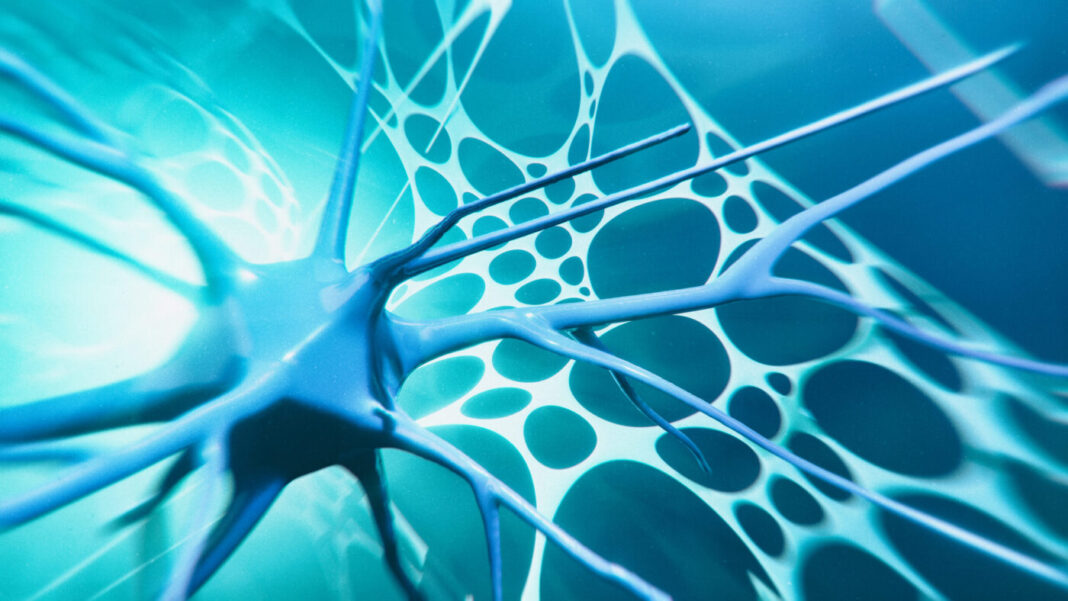Researchers at the Francis Crick Institute and University College London (UCL) have studied how proteins accumulate in the wrong parts of brain cells in motor neurone disease, and have demonstrated how it might be possible, in some cases, to reverse this. Amyotrophic lateral sclerosis (ALS), more commonly known as motor neurone disease, is a progressive fatal disease that affects nerve cells in the brain and spinal cord, causing loss of muscle control, with patients become increasingly paralyzed and losing the ability to speak, eat and breathe.
A common occurrence, in 97% of ALS cases, is the abnormal accumulation of proteins involved in the regulation of RNA (RNA binding proteins) from a motor neuron’s nucleus into the surrounding cytoplasm.
In a new study (“TDP-43 and FUS misvocalization in VCP mutant motor neurons is reversed by pharmacological inhibition of the VCP D2 ATPase domain”), published in Brain Communications, the researchers used motor neurons grown in the lab from skin cells donated by patients with ALS and showed it is possible to reverse the incorrect localization of three RNA binding proteins. The patients who donated cells all had mutations in an enzyme called VCP. This mutation is only present in a small proportion of ALS cases.
“RNA binding proteins have been shown to play a key role in the pathogenesis of amyotrophic lateral sclerosis (ALS). Mutations in valosin-containing protein (VCP/p97) cause ALS and exhibit the hallmark nuclear-to-cytoplasmic mislocalization of RNA binding proteins (RBPs). However, the mechanism by which mutations in VCP lead to this mislocalization of RBPs remains incompletely resolved,” write the investigators.
“To address this, we used human-induced pluripotent stem cell-derived motor neurons carrying VCP mutations. We first demonstrate reduced nuclear-to-cytoplasmic ratios of transactive response DNA-binding protein 43 (TDP-43), fused in sarcoma/translocated in liposarcoma (FUS) and splicing factor proline and glutamine rich (SFPQ) in VCP mutant motor neurons. Upon closer analysis, we also find these RBPs are mislocalized to motor neuron neurites themselves. To address the hypothesis that altered function of the D2 ATPase domain of VCP causes RBP mislocalization, we used pharmacological inhibition of this domain in control motor neurons and found this does not recapitulate RBP mislocalization phenotypes.
“However, D2 domain inhibition in VCP mutant motor neurons was able to robustly reverse mislocalization of both TDP-43 and FUS, in addition to partially relocalizing SFPQ from the neurites. Together these results argue for a gain-of-function of D2 ATPase in VCP mutant human motor neurons driving the mislocalization of TDP-43 and FUS. Our data raise the intriguing possibility of harnessing VCP D2 ATPase inhibitors in the treatment of VCP-related ALS.”
Abnormal location of proteins
The team found that the abnormal location of these proteins can be caused when the VCP enzyme is mutated, which has been shown to increase its activity. Importantly, when the researchers blocked the activity of this enzyme in diseased cells, the distribution of proteins between the nucleus and the cytoplasm returned to normal levels. The inhibitor they used is similar to a drug which is currently being tested in phase II cancer trials and also blocks the activity of VCP.
“Demonstrating proof-of-concept for how a chemical can reverse one of the key hallmarks of ALS is incredibly exciting,” says Jasmine Harley, PhD, author, and postdoctoral researcher in the Human Stem Cells and Neurodegeneration Laboratory at the Crick. “We showed this worked on three key RNA binding proteins, which is important as it suggests it could work on other disease phenotypes too. More research is needed to investigate this further. We need to see if this might reverse other pathological hallmarks of ALS and also, in other ALS disease models.”
Work to try and understand the disease mechanisms of ALS is ongoing, as seen in a second study the same group recently published in Brain. The scientists investigated intron-retaining transcripts, sections of RNA that are usually spliced, which also move from the cell nucleus to cytoplasm in ALS. By analyzing RNA in diseased motor neurons, they identified over 100 types of intron-retaining transcripts in the cytoplasm.
According to Giulia Tyzack, PhD, author and project research scientist in the Human Stem Cells and Neurodegeneration Laboratory, “We were quite surprised about the number of different intron-retaining transcripts we found in cells with ALS, which exit the nucleus and enter the cytoplasm. We were not expecting to observe this to this degree.”
“To imagine what’s going on here we can consider watching a movie at the cinema,” adds Jacob Neeves, PhD, author and scientist at the Human Stem Cells and Neurodegeneration Laboratory. “Typically, we don’t expect to see adverts throughout the film, but, if something goes wrong these ads might start cropping up at odd and unexpected points. These retained introns are a little bit like these abnormal ad breaks.”
The scientists suggest that the collection of intron-retaining transcripts in the cytoplasm may be a factor which attracts RNA binding proteins to move into the cytoplasm, although more research is needed to confirm this.
“Together, our two papers show how laboratory science is furthering our understanding of such a complex and devastating disease and provides some reassurance that the development of effective treatments may be possible in the future,” notes Rickie Patani, PhD, senior author, group leader of the Human Stem Cells and Neurodegeneration Laboratory at the Crick, Professor at UCL’s Queen Square Institute of Neurology, and a consultant neurologist at the National Hospital for Neurology and Neurosurgery.







